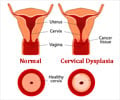Cervical cancer mortality has been reduced by 63% with the use of the HPV-DNA test, recommended by the WHO's screening guidelines.
- Cervical cancer is caused by human papillomavirus (HPV) and is most prevalent among women in low- and middle-income group of countries
- WHO guidelines on cervical cancer screening recommend shifting from the routine pap smear test to the HPV-DNA test– a test that detects the presence of HPV infection //
- HPV-DNA test identified women at high risk of developing cervical cancer and has lowered its mortality rates by 63%
What is Cervical Cancer?
Cervical cancer is a condition of abnormal growth of cells in the cervix– the entrance to the uterus from the vagina. Cervical cancer is majorly caused by infection with high-risk human papillomaviruses (HPV) spread by unprotected sex, multiple pregnancies, prolonged use of birth control measures, HIV infection, and among others.The majority of cases of cervical cancer can be addressed with effective primary interventions like the HPV vaccine and secondary preventive strategies such as screening and treating the precancerous lesions. As long as it is identified early and treated appropriately, cervical cancer is one of the most curable types of cancer.
WHO Guidelines for Cervical Cancer Screening
The WHO recommended a new guideline in 2021 that an HPV DNA-based test be used instead of the most widely used pap smear test-- visual inspection of precancer lesions with acetic acid (1✔ ✔Trusted SourceNew recommendations for screening and treatment to prevent cervical cancer
Go to source).
HPV-DNA testing identifies high-risk HPV strains. HPV-DNA testing is an objective diagnosis that doesn't tell the presence of cancer. Instead, the test detects the presence of HPV, reflecting the high risk of developing cervical cancer.
Transforming Cervical Cancer Survival Through HPV-DNA Test
The Daffodil Centre, a collaboration between Cancer Council New South Wales and the University of Sydney, conducted research on HPV screening in 78 countries and various screening options for women living with HIV (2✔ ✔Trusted SourceBenefits, harms and cost-effectiveness of cervical screening, triage and treatment strategies for women in the general population
Go to source).
Nearly all cervical cancers are caused by HPV, and switching from Pap tests to HPV screening in low- and middle-income nations could drastically lower death rates through early interventions.
HPV screening was the most clinically effective and cost-effective, reducing mortality by 63-67 percent conducted on a five-year basis.
“Low-and-middle-income countries bear most of the world’s cervical cancer burden, so demonstrating the effectiveness of HPV-based screening compared with other approaches is crucial to advocacy to support the WHO strategy and guidelines,” said Dr. Simms, the lead author of the study.
The study, which focused on Tanzania, found that low-to-middle-income nations had higher rates of co-occurring HIV and HPV infection. Compared with the general population, women living with HIV had a six-fold increased risk of cervical cancer.
“We modeled several scenarios in relation to outcomes in Tanzania, which has one of the world’s highest HIV infection rates, and found that primary HPV testing with triage compared with no screening would reduce cervical cancer mortality by up to 71 percent,” Dr. Simms said.
“This equated to saving a life for every 38 women screened and referred for pre-cancer treatment — a solid result in relation to the benefits of cancer screening,” he added.
The findings of the study compiled following the WHO's cervical screening recommendations for women in general, suggest primary HPV screening to begin at age 30 and repeat the test every 5 or 10 years.
Given the precise cervical cancer screening guidelines by WHO, there needs a global initiative and awareness of accessible screening and treatment options to lower the mortality due to cervical cancer.
References:
- New recommendations for screening and treatment to prevent cervical cancer - (https://www.who.int/news/item/06-07-2021-new-recommendations-for-screening-and-treatment-to-prevent-cervical-cancer)
- Benefits, harms and cost-effectiveness of cervical screening, triage and treatment strategies for women in the general population - (https://www.nature.com/articles/s41591-023-02600-4)
Source-Medindia
















